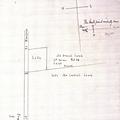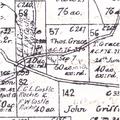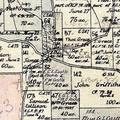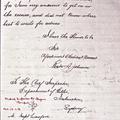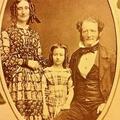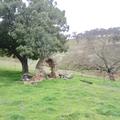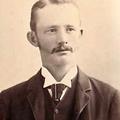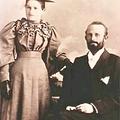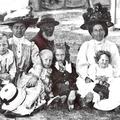< Early Canberra Government Schools
Cavan [1882 - 1895]
Cavan Station
Cavan is a sheep and cattle grazing district 30 km south of Yass, accessed via Wee Jasper Road. In the wake of Hamilton Hume's explorations in the 1820s, stockmen, farmers and graziers began to claim the best lightly timbered country and grassy flats close to the Murrumbidgee River. Irish-born William Riley established Cavan station on nearly 2000 acres he acquired in 1833 - naming it after the Riley family's home county in Ireland. His family also had claim to 'Cavan's Run', a vast squatting domain of 51,000 acres nearby.
William Riley's tenure of Cavan was rather brief, as he died a young man (only 28) in 1836. His wife also died young, out-living him by only 2½ years and leaving three children to be raised by her sister at Denham Court, near Campbelltown. The property then became leased - first to Major Edmund Lockyer and his son-in-law, Captain George Potter, and from about 1857 to (Joseph) Frederick Castle and his business partner, James Calvert.
When Calvert migrated from England to Australia in 1841, he became acquainted with Ludwig Leichhardt during the voyage. Three years later he went with Leichhardt on his famous expedition from Brisbane to Port Essington. Lucky to survive, Calvert did no more exploring. After teaming up with Castle in Sydney, he became the manager of Cavan station, while Castle (a school headmaster) remained in Sydney. In 1869 Calvert married Louisa Atkinson, a distinguished writer and naturalist. The next year, they left Cavan and settled at Swanton, near Sutton Forest. When Louisa died in 1872, Calvert returned to Sydney and led a retired life. He died at Sydney in 1884.
English-born Frederick Castle was a well-educated man who migrated to Sydney in 1838, aged about 28. He took up a teaching position in Sydney, waiting for his fiancée, Eliza Goulstone, who followed him out from England. However only a month after they married in Sydney, Eliza died. Castle then moved to the Hunter region where he entered into a farming partnership with an Irish immigrant, Frederic Roche. In 1846 Castle married his partner's sister, Wilhemina Roche, then the couple moved back to Sydney when Castle chose to resume a teaching career.
During the booming gold-rush economy of the 1850s and 1860s, Castle became a well-respected headmaster of Calder House, at New Town, one of Sydney's leading private schools. His home residence was Austenham House at the head of Lane Cove - a gracious family home with extensive grounds and beautiful views. He and Wilhemina had at least two children, however their only surviving child was Eliza, who was born in 1849.
Quite prosperous by this time, Castle was able to convert his leasing of Cavan into ownership when the station came up for auction in July 1862; his winning bid being ₤1,425. As advertised, it was a property of 1,920 acres with 'a brick-built barn, large woolshed, four dwelling huts, two sheds, two stockyards and the remains of Cavan Cottage, of which the walls are standing'. When James and Louisa Calvert left Cavan in 1870, Frederick Castle (then 60) and family left Sydney to become permanent residents of his Murrumbidgee property.
[Cheryl Mongan, 'Cavan Station: 1832-1966', Boongaroon, vol 27, no 4, Dec. 2011, Yass & District Historical. Society]
Cavan's first school, 1882
The first requests to have a public school at Cavan were led by Frederick Castle from the time he became a resident on the property. On 26th November 1877 he submitted a formal application for the 'Establishment of a Public School', nominating four residents and himself as a local school committee should the application succeed. A good location for the school, he wrote, would be 'on the Nth Side of Ellison's Free Selection near Yass River – an admirable site'. The group who signed the document provided their status and religion as follows: 'FJ Castle JP - Grazier C/E; Chas. Hall JP - Grazier C/E; Edward Clark - Free Selector C/E; John O'Donnell - Free Selector RC; SM Ryrie - Farmer E/C.'
[For all Dept. of Educ. records quoted: 'Cavan Public School', 5/15343.1, NSW Archives.]
Assessing this application in January 1878, District Inspector Murray noted that there were 36 children within 4 miles of the proposed school site, but of these 11 were not likely to be enrolled as 6 were too young and 5 too old. Advising that the application be declined, he commented as follows: -
'This application originated with Mr Castle, an educated gentleman residing in the neighbourhood, but even Mr Castle with all his desire to have a school established has hardly any hope of its success, for he told that "were a building erected and a School established he feared that the few people about would not send their children to it but keep them at home working" – Recommend that the applicant be informed that there are insufficient children within a 2 mile radius for the required attendance to be guaranteed.'
Castle persisted, seeking any support he could muster. In exasperation, he wrote to the Department of Education in June 1878: 'I have been trying to arrange for a Half-time or Provisional School in the Parish of Cavan – offering land for a site, and promising to supplement local effort for nearly 8 years – the Reverend W.H.H.Yarrington has since promised to try the effect of Clerical Eloquence, as lay persuasion (has) proved utterly ineffective.' The reverend's assistance, however, came to no avail.
Three years later, Castle renewed his campaign, writing directly to the Department of Public Instruction on 23rd June 1881. He reminded the Secretary that for 10 years he had been attempting to secure a provisional school for the local community. The last application, he said, had been for a school on the eastern side of the Run, and now this request was on behalf of the Run's western residents. In particular he inquired: 'what assistance will be granted towards the building of a School House and Teacher's Residence for these poor people who have between twenty and thirty children fit for school. Having heard that the Department of Education assists the Navvies (railway fettlers) by furnishing Tents and Teachers for them - they are emboldened to press their claim to favourable consideration - pleading fixed residence and greater poverty.' The letter concluded: 'I called at your office when last in Sydney but found you engaged three deep and was unable to call again.'
Invited by the secretary, it seems, Castle submitted another public school application on 1st July 1881, signed this time: 'J Fred. Castle JP - Squatter, T. Ryrie - Sheep Farmer, Andrew Roche - Sheep Farmer, Edward Clark - Sheep Farmer, Arthur Webster - Station Superintendent'. The form indicated that 26 children within a 3 mile radius would enrol: John Archer's children - Walter 11, Stanley 9, Ethel 8, Alice 6, and Ada Vallance 12 (being raised by him); John Thatcher's - Alfred 13, Thomas 11, Ellen 9 and Lucy 7; Robert Webster's - Florence 8 and John 6; John Grace's - Patrick 9, John 7 and Kate 5; Edward Tobin's - William 13, Mary 11, Rebecca 9, Sarah 6 and Florance 4; James Collison's - David 15, Sarah 10, Thomas 7 and James 5; Ellen Coady's - Rebecca 11 and Lucy 6; and James Kelly's Catherine, who was 8.
In support of the application, Castle forwarded a neatly drawn scale map showing all the parents' properties and the long distances from them to other schools: Good Hope, across the River, 7 miles through rugged country; Yass, 16 miles; Tumut, 40 miles (see map below). All the parents would gladly send their children, he wrote, and there were other children six or seven miles away, who might well enrol. The school site indicated on this map was in west Cavan, on the north-east corner of a 100 acre block owned by one of the parents who had conditionally purchased it as a free selector. Regarding water access, he noted: 'The situation of the proposed school is on a dry limestone plain with a spring of water very near it'.
[J Fred. Castle, Cavan, to W Wilkins Esq, Dept. of Educ. Secretary, Macquarie St Sydney, 15 July 1881, 5/15343.1, NSW Archives]
The proposed site had a wooden-slab building on it, intended to serve as a schoolhouse until the community could afford to build a better one. As this was normal procedure for provisional schools (built by a local community, not the government) it was found on inspection to be acceptable, and officially approved on 30th November 1881. Some volunteer parents then set to work renovating the building for school use.
On 18th February 1882, Castle notified the Department that the school was ready to open: 'A building of slab has been got ready and furnished with desks, forms and Blackboard – all that is now wanted is a Teacher, and we hope from your kindness, a suitable person will soon be supplied. No dwelling has yet been provided, but a single man would be for a few months boarded and lodged by the Parents of the children and as soon as the school is in working order and we can be certain of a fair average attendance – no time will be lost in building a cottage for a Teacher's residence. Hoping for a favourable consideration of our case, ... J Fred. Castle'.
Appointed by the Department, William H Bullen arrived at Cavan later that month and enrolled the first pupils in March 1882. It had been quite a struggle to gain the school, the achievement of which owed much to Frederick Castle's determined campaign over many years.
The quest for a bigger and better school
In July 1882 Castle wrote to the Department about two school matters. Firstly, he was 'happy to bear testimony to the care and attention of Mr Bullen the Tutor, of whose zeal (he) heard many warm considerations from the grateful Parents'. Secondly, that as pupil attendances had been favourably demonstrated, the next step was to erect a better schoolhouse, on 'say 2 acres or more ... cheerfully given by myself'. He had in mind a new rubble stone building with a galvanised roof, 30 x 20 feet, a short distance from the present school. It would cost about 150 pounds, he estimated, which he hoped would be partly funded by the Department, as 'the parents being Free Selectors and labourers are far less able to give effective help towards buildings than are dwellers in towns'.
Requested to comment, District Inspector Hicks considered the existing school did not warrant further expense as it had only been operating five months and was yet to be visited by an inspector. He also pointed out that average attendances in the March and June quarters had been 15.4 and 17.4, whereas a public school required 22. A superior concurred, commenting on the report: 'These numbers do not justify conversion of the Prov. School into a Pub. School'.
As always Castle pressed his case, replying that he was informed these enrolments had actually been 18.5 and 19.9, and would have been higher had there been fewer absences from sickness due to the poor state of the building and farming demands on some of the older pupils. In his actual words, the letter read: -
'From the very open state of the miserable building used as a school, nearly all the children have suffered from cough and catarrh, so that I fear the school has been closed for a time, and this makes me very anxious that some building should be erected before next winter – or a total failure will ensue. The average of the present quarter will be low from the sickness just mentioned, and also because shearing and harvest will demand the help of any lad who can be made serviceable in the shearing shed or harvest field for we have no surplus labour – but after Christmas no doubt the average of attendance will be 20 if not more and I earnestly hope the department will favourably consider the poor children..... J. Fred. Castle'.
Additionally, Castle mounted political support from the Member for Yass Plains, L F Heydon, who informed the Department in September 1882 that 'the case of the Cavan School is as strong a case on almost every possible ground as any school could have'. He also appealed directly to the Minister, pointing out that the current building was on the property of a selector who wanted to use it, and that with an enrolment over 20, the school had the requisite numbers to be made a public school.
At first the Department stood firm, reiterating that as the average attendance figures were still less than required for a public school, 'no public money could be expended in erecting new buildings'. Then in May 1883, a compromise was offered: if the residents of Cavan were willing to build the school, then the government would contribute 2/3 of the cost, providing it was built in accordance with regulations. Sadly Castle did not live to see this victory materialise, as he died at Cavan homestead on 22nd May, aged 72, after a protracted illness. Almost certainly, however, he would have heard the news.
When news of his death reached Sydney, the Sydney Morning Herald paid tribute to the former Calder House headmaster: 'Mr Castle for many years kept a school in the vicinity of Sydney, and very many of the most prominent men of the present day in Parliament, in the learned professions and in mercantile circles owe much of their subsequent success in life to his teaching. Mr Castle was a man of great intelligence and genial disposition, and his memory will long be cherished by his friends and former pupils'. (SMH, 14 June 1883)
In August 1883, average pupil attendances having consistently exceeded 22, Cavan provisional school was re-classified a public school. As a result, parental interest in building a better school gathered momentum. A few months passed, then Thomas Grace, a parent who owned some land close to the existing school, wrote to the Department offering part of it as a school block for 5 pounds an acre. The site he proposed was 3/4 mile from the old school on the southern side of the road from Bloomfield to Tumut, two acres in size (Site 203, portion 57, Taemas Parish). After inspection, it was formally surveyed and approved for purchase.
From here on, matters steadily progressed towards the opening of a new public school. In April 1884, the Government Architect estimated that a wooden building for 30 pupils on 2 acres of fenced land, with requisite furniture and two water closets, would cost about ₤225. Quickly determined too expensive, District Inspector Lawford was invited to suggest a cheaper alternative costing no more than ₤100. So instructed, he submitted his own specifications for a more basic building: -
'Dimensions 17ft x 14ft x 9ft. Walls to be of sawn hardwood slabs 2in thick battened at joists outside. Floor of pine on hardwood joists. Fireplace of wood to be lined with stone 3ft x 2ft. Door of pine hung with stout hinges & fastened with carpenter's rim lock. Windows: two double sash glass windows to slide up and down. Roof: to be of galvanised iron, gable ended, 2 corrugate laps. WCs: two to be erected, properly fitted with doors and seats, soil pit 4ft deep'.
Inspector Lawford estimated that this would cost the Department about ₤60 (after the parents contributed their 1/3 of the total cost) and take 12 weeks to build. By February it was approved and tenders collected: from Thomas Grace, ₤100; Joseph Newman, ₤56 completed in 8 weeks; and from Robert Webster, a note declining - doubtless unable to compete with Newman. The lowest tender accepted, Newman began building immediately. On 31st March 1885 Lawford reported: 'I visited this place yesterday. The contract has been most faithfully performed'.
Staffing changes and challenges
During the 14 years that it was open, Cavan School had six teachers. William Bullen and Arthur Bundock served all but 18 months of the time and the other four, a few months each. The following overview briefly outlines some of the incidents that were brought to the Department's attention about their service.
Cavan's first teacher, William H Bullen, served four years from February 1882 to December 1885. By all accounts he was liked and respected by the community. During the school's first inspection, however, some irregularities in his record keeping raised serious concern. For some reason he wasn't present at the school when Inspector Lawford arrived in May 1883, so Lawford let himself in and perused the school documents. Finding pupil absences not reported and no lesson programmes, timetable or lesson register maintained, Lawford recommended that Mr Bullen 'be reprimanded for his neglect and informed that any future lapses in these matters will be severely dealt with'. Chief Inspector Hicks concurred, adding that Bullen be called on to explain.
'The following are my excuses', Bullen replied; then went on to explain. Firstly, he wasn't aware that absences due to heavy rain and flooded creeks needed to be reported. Secondly, in relation to the lesson documents, he was 'totally ignorant that forms for these were to be supplied by the teacher', because none had been sent when he opened the school. Hence, he had formed the opinion they were not used in provisional schools.
Given that Bullen had met the competency requirements of pupil-teacher training, these were clearly lame excuses. However, in view of his otherwise good record, Inspector Lawford thought some leniency should apply: 'As this is Mr Bullen's first omission of duties and has regularly notified me since of the non-attendance of pupils it will be sufficient if he is cautioned to be more careful in future'- to which Chief Inspector Hicks concurred. Their confidence that William Bullen could learn from his mistakes was not misplaced: in September 1885 he was promoted by examination to class 3b.
The next teacher, Frederick Grovenor, succeeded Bullen in January 1886. An unmarried eighteen-year-old young man, he served only six months at the school before being transferred due to a serious parental complaint. On 28th June, Thomas Grace, Robert Webster and A. Wade wrote to Inspector Lawford as follows: 'We the undersigned parents of children attending the Public school at Cavan beg to draw your attention to the incompetence of the teacher now in charge, Mr Grovenor. We consider that he is really unfit for the position and respectfully ask that another teacher may be sent; and until another teacher be appointed we do not intend to send our children to the school'.
Reporting this to Chief Inspector O'Byrne, Lawford briefly advised his superior on the situation at hand: 'Mr Grovenor seems to take very little interest in his work and the school had decidedly gone back when I examined it. Recommend that Grovenor be sent to Cullagong and Miss Kate Johnson from that school be sent to Cavan. She is an applicant for removal and it is very desirable that both of them be moved. I have ascertained that accommodation can be had for Miss Johnson at Cavan'.
O'Byrne considered Lawford's suggestion rather irregular, but a useful solution to the similar situations the two teachers were facing. On the report he remarked: 'Action recommended by Mr Lawford is rather a summary one. A report on the alleged incompetency of Mr Grovenor should accompany these papers. However as the schools are about of the same standing, and both teachers are unpopular, the proposed exchange will give both a fresh start to do better. I have therefore concurred in the recommendation'.
As to Miss Johnson's problem, her short teaching career was showing little promise, as she herself conceded. Her first appointment to Talmo Provisional had lasted two months, followed by one year at Bookham Public, then four months at Cullagong Provisional. During this period she had failed her examination three times, and at Bookham, had resigned for two months to regain her health. When she applied to be moved from Cullagong in June 1886, she was twenty and unmarried. Her request to be transferred (in beautiful copperplate) touchingly conveys the challenges many a young teacher faced, having no peer to confer with, at a remote bush school: -
'Although I have done my best to pass my examination I dare not hope that I shall do so. I like teaching, and would like to remain in the service but this being the third Examination I have attended, hitherto 'unfortunately" without success, I should be ashamed to go again if I could not feel confident that I should pass. May I hope for a removal to some School near, where I could get instructions from a good Teacher. I should have gone to some good Training Master to be instructed in all the required Branches long ago but I have not the means to do so.
If I am doing wrong in writing thus, I hope it will be overlooked, for I am very anxious to get on in the service, and did not know where best to write for advice'.
Inspector Lawford noted on her request: 'I have recommended Miss Johnson's removal to Cavan near Yass, which I think will meet her wishes'. Unfortunately there are no indications how Kate Johnson settled in at Cavan, or why, only two months later, she either transferred or resigned from the school.
Arthur Bundock, the longest serving teacher at Cavan, replaced Kate Johnson in September 1886. Twenty-two when he arrived, his previous five years of service had also been inauspicious. First appointed to Binalong as a pupil-teacher in 1881, he was transferred to Frogmore in March 1883, then failed his examination that December. The next year he was moved to Milong Provisional, where he failed the examination again. Disrated at Milong, he was removed to Cavan as a reprimand for 'laziness'.
When he arrived at Cavan, Bundock was also in financial straits and being chased by creditors. While a pupil-teacher at Frogmore he had fallen behind in paying board and had failed to comply with a court order to repay 8 pounds 10 shillings. As well, he was being pressed by a bailiff at Burrowa to repay another landlord 7 pound 10 shillings, as determined by the Burrowa court of petty sessions. He had agreed in court to repay 1 pound 10 shillings per month, but had failed to do so. After a year at Cavan he was still in debt, being questioned by the Department over a complaint received from Samuel Pearsoll, who had written: 'It seems a hard matter one cannot get paid by those Public School Teachers for them boarding people, will have to board them for nothing soon for they will not pay their debts if they can get out of it.'
At first the Department simply brought these matters to Bundock's attention, however when another creditor queued up in 1887 - a Mrs Charlotte Jones at Young, who accused him of 'unmanly like conduct' in not paying what he owed her - Inspector Lawford recommended a reprimand for his 'want of care in not completing a defaulter's return'. Brought to the attention of the Department's under secretary in Sydney, the matter was finally put to rest when he determined: 'a caution will be sufficient on this occasion'.
Cavan School briefly closed in August 1893, then re-opened on a house-to-house basis with Warham, which served the nearby Warroo community. Bundock was appointed teacher at both, boarding with John Grace at Cavan. Before long, he became the suitor of John Archer's eldest daughter, Ethel, and they were married at Warroo in June 1894 (Ethel, 21 and Arthur, 30). However when their child was born in December that year, there was some gossip about Ethel's pre-marriage pregnancy. Just two weeks after the birth, a Warroo resident named Thomas Howall wrote directly to the Department's under secretary requesting that Arthur Bundock be moved to some distant school for the moral good of the community. The letter read as follows: -
'I send you the undermentioned facts which speak for themselves to show you the sort of teacher we have to teach his pupils the principles of morality. Married at Warroo 24th June 1894, Arthur Bundock to Atty Archer. Birth at Royal Hotel Yass 13th Dec'r 94, Mrs Bundock of a son not six months.
In sending this I do not wish him any harm but as ther (sic) are a deal of talk about it, I think it would be wise to remove him to some place whare (sic) the facts are not knowing as I think the School will not be supported now – perhaps I ought to have sent this to the district Inspector but I think he must know and I thought it best to send it to you.'
When this came back to the Yass district inspector Mr Sheehy for comment, he began by asking Bundock (not mentioning the letter) who the man was and whether he had pupils at the schools. Informed by Bundock that Howall was a Waroo farmer whose children had been privately taught, Sheehy recommended that the matter be dealt with as follows: -
'Mr Howell has no children attending Cavan and Warham H to H school. His children have always been taught privately. It would appear therefore, that his motive for suggesting the removal of the Teacher is not solicitude for the welfare of the school. I have received no complaint about Mr Bundock from any other resident. The question of removing him should, I think, be deferred till after the next inspection of his school. I recommend that Mr Howall be informed accordingly.' (Memo, 4 Feb 1895)
Although the under secretary concurred, the Minister for Public Instruction thought differently: Bundock was summarily removed to Chain of Ponds public school (near Gunning) on 28th February 1895. Both at Cavan and the many other schools he later served at, Arthur Bundock was by all accounts a popular, well-respected teacher. A skilled sportsman himself, at cricket especially, he enthusiastically encouraged all sports wherever he taught. In 1913 he contracted hydatids when he was 48. He had successful surgery for it, but died not long after the operation from a weak heart.
The next teacher, William Faulder - aged 25 and single, was the youngest son of Thomas Faulder of Yass. Faulder transferred from Brooklands provisional school, (near Ginninderra) in March 1895 and accepted lodging at John Archer's residence, about a mile from Warham School. The two schools had just been upgraded from house-to-house to half-time status, so Faulder's teaching week was divided between them. He may have been a temporary appointee, as he served only two months at Cavan before transferring to a provisional school at Griffith's Flat (near Nanima). In later years he had a long and distinguished teaching career before retiring to Goulburn where he died in 1947, in his 78th year. An obituary said of William Faulder, 'he had one of those quiet, charming and unassuming personalities which made him beloved of his scholars and held in the highest regard by the parents and his many friends'.
Cavan's last teacher was Albert Alchin, who transferred from Griffith's Flat and Jeir half-time schools in April 1895. Twenty-five and single, he lodged at John Archer's residence at Warroo. His move away from the school was due to its closure six months later, in December 1895. By 1900 he was teacher-in-charge with an assistant at Berebanglo and Waggallala half-time schools; however his career was fairly short, as he retired in 1908 and became a baker in Gunning. He died five years later, aged only 42, from a heart condition.
After closing due to insufficient pupil numbers, Cavan School never re-opened. What became of the school building is not known to this writer, but might well be stored in someone's memory. Any information of this kind would be gratefully received by the staff at Hall School Museum.
[Contributed by Keith Amos, former teacher at The Mullion, not far from Cavan.]
Location Map
Related Photos
Teachers
- Bullen, Mr William H
02/1882 - 12/1885 - Grovenor, Mr Frederick
01/1886 - 06/1886 - Johnson, Kate Ann
07/1886 - 09/1886 - Bundock, Mr Arthur J
09/1886 - 03/1895 - Faulder, Mr William Patrick
03/1895 - 04/1895 - Alchin, Mr Albert
04/1895 - 12/1895
NSW Government schools from 1848
- Cavan (external link)
< Early Canberra Government Schools
If you are able to assist our work of identifying, documenting, and celebrating the early bush schools of the Canberra region, please contact us or .


